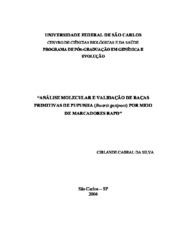Análise molecular e validação de raças primitivas de pupunha (Bactris gasipeaes) por meio de marcaodres RAPD
Abstract
Molecular markers were used to examine the genetic variability of eight
landraces of peach palm (Bactris gasipaes var. gasipaes) and two wild
populations (B. gasipaes var. chichagui), their relationships and genetic
structures. Two hundred plants of these 8 races were used and 18 plants of the
two wild populations, one from the Magdalena River, Colômbia, and the other
from the Xingu River, Pará, Brasil. Eight primers were used to generate RAPD
markers, of which 124 markers were obtained with 101 polymorphic. The
observed heterozygosity of the set of landraces and wild populations was 0.38,
with 93 % polymorphism, both slightly greater than in earlier studies. The
Amazonian landraces had greater heterozygosity and % polymorphism than the
Central American race. The structure of the dendrogram based on Nei s (1972)
distances with the four previously studied landraces was similar to that study,
essentially validating it and confirming two landrace groups one Occidental
and one Oriental. When the Juruá landrace was added to the analysis, it joined
with the other Occidental races, as expected by its geographic position. When the
other landraces (with small sample sizes) were added to the analysis, a
consistency and some problems were observed. The consistency was that all the
landraces joined the Occidental group, expected by their geographic positions.
The problems were the grouping of the Vaupés landrace with the Juruá landrace,
which are geographically distant and have different fruit sizes and shapes. The
relationship between the Cauca landrace and the Inirida landrace was also
problematic, since they are geographically separated. These problems can only
be resolved with new germplasm collections in the appropriate geographic areas
and with an appropriate number of individuals. The two wild populations joined
the landraces at a great distance, suggesting that they did not participate in the
domestication of the cultivated landraces and indirectly reenforcing the
hypothesis of a single origin in southwestern Amazonia.
